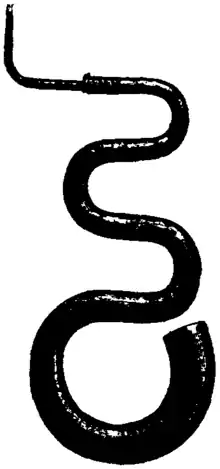Sopranino recorder
The sopranino recorder is the second smallest recorder of the modern recorder family, and was the smallest before the 17th century.
| Part of a series on |
| Musical instruments |
|---|
| Percussion |
| Keyboards |
This modern instrument has F5 as its lowest note, and its length is 20 cm. It is almost always made from soft European or tropical hardwoods, though sometimes it is also made of plastic.
Historically there were several sizes of recorder in this register, named differently in different periods and in different languages. In his Syntagma Musicum (1619), Michael Praetorius describes this size of recorder, only a whole tone higher, with G5 as its lowest pitch. He calls it exilent (highest) in Latin, and kleine Flöte (small flute), klein Flötlein (small little flute), or gar klein (really small) in German. According to Praetorius, it is the smallest of eight sizes of recorder in a complete "Accort oder Stimmwerk" (set of all voices), and sounds a quintadecima (a fifteenth—that is, two octaves) higher than a cornett (Praetorius 1619a, 13, 21, 34). Such a complete set includes a total of twenty-one instruments, including a pair of exilents, and two each of the two next larger sizes, Discantflöten in D5 and C5. However, Praetorius recommends restricting recorder ensembles to the five deepest sizes, because "die kleinen gar zu starck und laut schreien"—"the small ones scream so" (Praetorius 1619b, 158; Baines 1967, 248).
The sopranino in G is most probably the instrument Claudio Monteverdi calls for in L'Orfeo (1607), by the name flautino alla vigesima seconda (little flute at the third octave) (Lasocki 2001a).
In 18th-century England, the sizes of recorder smaller than the treble in F (which was called simply "flute") were named according to their interval above it, and often were notated as transposing instruments. The descant (or soprano) on C was called a "fifth flute", the instrument a whole tone higher still was the "sixth flute" (on D), and what is known today as sopranino was the "octave flute" (Lasocki 2001).
References
- Baines, Anthony C. 1967. Woodwind Instruments and Their History, third edition, with a foreword by Sir Adrian Boult. London: Faber and Faber. Reprinted with corrections, 1977. This edition reissued, Mineola, New York: Dover Publications, Inc., 1991, and reprinted again in 2012. ISBN 978-0-486-26885-9.
- Griscom, Richard W., and David Lasocki. 2013. The Recorder: A Research and Information Guide, third edition. Routledge Music Bibliographies. Routledge. ISBN 9781135839321.
- Hunt, Edgar. 1988. "Syntagma Musicum II, Parts 1 and 2 of De Organographia by Michael Praetorius; David Z. Crookes" (review). The Galpin Society Journal 41 (October): 142–44.
- Lasocki, David. 2001a. "Flautino (i)". The New Grove Dictionary of Music and Musicians, second edition, edited by Stanley Sadie and John Tyrrell. London: Macmillan Publishers.
- Lasocki, David. 2001b. "Recorder". The New Grove Dictionary of Music and Musicians, second edition, edited by Stanley Sadie and John Tyrrell. London: Macmillan Publishers.
- Praetorius, Michael. 1619a. Syntagmatis Musici Michaelis Praetorii C. Tomus Secundus De Organographia. Wolfenbüttel: Elias Holwein, in Verlegung des Autoris.
- Praetorius, Michael. 1619b. Syntagmatis Musici Michaelis Praetorii C. Tomus Tertius. Wolfenbüttel: Elias Holwein.
- Sachs, Curt. 1913. Real-Lexikon der Musikinstrumente, zugleich ein Polyglossar für das gesamtr Instrumentengebiet. Berlin: Julius Bard.
